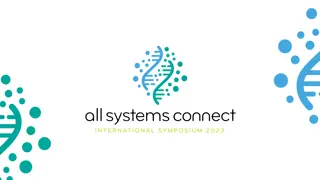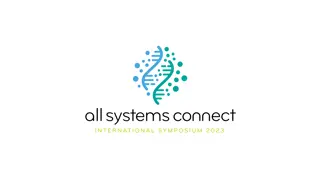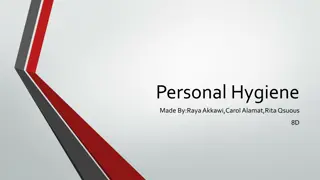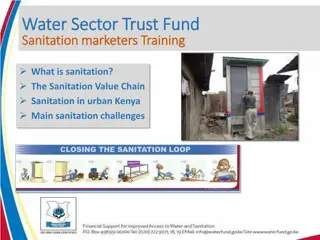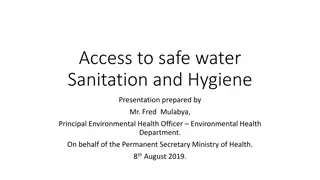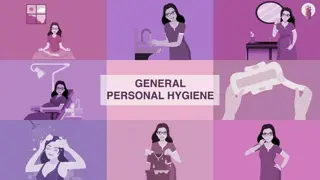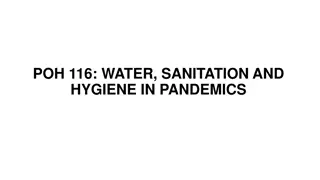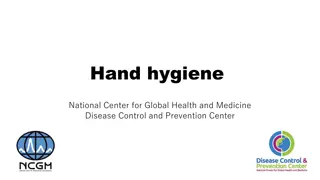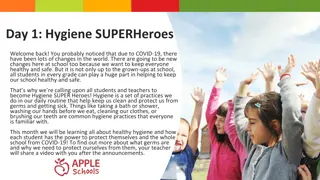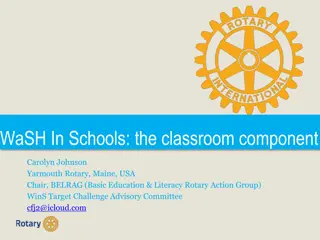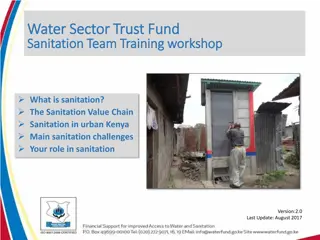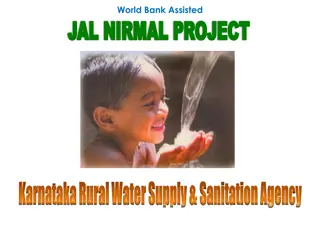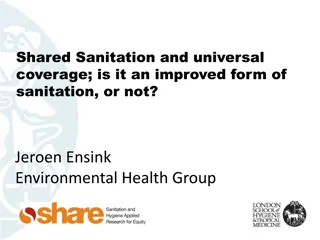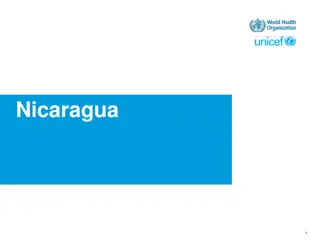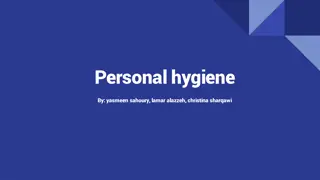Transforming Hygiene and Sanitation: Approaches and Challenges in Developing Countries
Various countries have implemented different approaches like PHAST, CLTS, and hygiene clubs to improve hygiene and sanitation in their communities. However, challenges such as the demanding nature of PHAST, the need for skilled facilitators, and the limited adaptability of these approaches to urban settings and authoritarian systems hinder progress. Additionally, issues like prescriptive delivery of sessions and perception of PHAST as outdated impact the effectiveness of these initiatives.
Download Presentation

Please find below an Image/Link to download the presentation.
The content on the website is provided AS IS for your information and personal use only. It may not be sold, licensed, or shared on other websites without obtaining consent from the author.If you encounter any issues during the download, it is possible that the publisher has removed the file from their server.
You are allowed to download the files provided on this website for personal or commercial use, subject to the condition that they are used lawfully. All files are the property of their respective owners.
The content on the website is provided AS IS for your information and personal use only. It may not be sold, licensed, or shared on other websites without obtaining consent from the author.
E N D
Presentation Transcript
Feedback from countries: Kenya Lesotho Malawi Sudan Burundi Uganda Kenya Ethiopia Ivory Coast Benin Haiti Philippines Indonesia Yemen Myanmar DPRK Afghanistan Bangladesh Vietnam Turkmenistan 2 Titel van de presentatie | datum
Approaches PHAST Participatory Hygiene and sanitation Transformation: Indonesia, Nepal, Sudan, Philippines, Ethiopia, Burundi, Ivory Coast, Myanmar, Vietnam, Haiti, Afghanistan, DPRK, Bangladesh, Turkmenistan, Lesotho CLTS - Community Led Total Sanitation (No subsidy): Malawi, Ivory Coast, Zambia, Kenya, Nepal (sanitation fund/loans), Ethiopia (slab distribution) PHAST/CLTS combination: Malawi, Ivory Coast, Ethiopia (POS Post ODF support), SLTS School Led Total Sanitation: Nepal, Kenya, ULTS Urban Led Total sanitation: Kenya, CATS - Community Approaches to Total Sanitation: Sudan (slab distribution), Sanitation Marketing (SanMark): Nepal, Ivory Coast, Kenya Social Marketing: Bangladesh RANAS Model - Malawi 3 Titel van de presentatie | datum
Approaches Hygiene Clubs: Nepal (Child club/ Junior Red Cross circle), Ivory Coast, Benin, Bangladesh (Mother Club), Lesotho (Health Clubs) Child to child approach: Kenya Model Home approach: Burundi, Uganda, CHAST Children Hygiene and Sanitation Transformation: Ivory Coast, Burundi, Philippines, Malawi, Sudan, Bangladesh, School Hygiene Education Promotion Programme (SHEPP): Kenya Hygiene promotion within CBHFA approach National Events: Global handwashing day Community-based O&M packages (national policy) for rural projects 4 Titel van de presentatie | datum
Challenges PHAST 1. PHAST is long and demanding process. Participation of community in all session becomes a challenge. 2. PHAST requires skilled and experienced, motivated facilitators as well as in-depth training of community workers. It is difficult to sustain the network. 3. PHAST is limited to specific contexts - mainly rural and in countries with culture of participation by civil society. It is difficult to adapt to urban settlements and countries with authoritarian systems. 4. Participatory methodologies are often facilitated in a prescriptive way. PHAST sessions for example are delivered as formal, educational lectures using mainly health-based messages. 5. PHAST has been adapted and changed over the years. The tool is currently eroded and in most countries, the original philosophy of PHAST is absent. 6. CLTS propaganda has irreversibly damaged the PHAST approach. It is perceived as an old, out of date, educational tool that need to be replaced. Donors have invested in CLTS (undermining other approaches, dictating selection of specific method) 7. PHAST equals delivering subsidies 8. PHAST in emergency: prescriptive, educational tool, mistaken with traditional PHAST, 9. PHAST based on health believe theory lack using different triggers for behaviour change 10. Lack of harmonization with other approches in RCRC 11. Government policies promotion CLTS approach 5 Titel van de presentatie | datum
Challenges - Methods, BC 1. Limited availablity & use of adapted IEC materials packages. Tendency to replicate standard materials from the MoH or global packages. 2. WASH software is not aligned with other health interventions implemented under the CBHFA approach (maternal and child health). 3. Low access to large scale funding opportunities (with extended project time frame) limit real application of software approaches. Difficult to have an extension period for low cost software activities at the end of project implementation. 4. Socio-cultural dynamics matter - no methodology is a one size fits all . 5. The health believe model ( changing behaviour to obtain health gains ) is still the predominant framework for behaviour change. New approaches which embraces emotional, habitual and cultural factors is needed (Social Marketing, Behaviour Change Communication, etc.). 6. Target audience often remains unknown. Promotional activities in WASH projects do not respond to the specific needs of different audience groups. 7. No formative research no real prioritization of hygiene needs and risks. Formative research not being the starting point. 8. Addressing needs of vulnerable groups (elderly, HIV AIDS, etc.) 9. Behaviour- centered designed: 7 motivators (LSHTM approach). 10. IFRC BCC framework. CBHFA revitalised with a stronger BCC component. 11. Link to the private sector (going to scale). Uniliver, Procter & Gamble, Nestle 12. Combining methodologies: taking elements from different models, open menu of tools 6 Titel van de presentatie | datum
Challenges - Sanitation 1. Sustaining ODF status in the community after project ends is challenging. 2. What happens with communities that do not reach ODF status? 3. No clear policy on subsidies by Government: Using subsidy and non-subsidy approaches simultaneously in the same district / province undermines the achievement of ODF status. 4. Non-subsidy approach in sanitation limits the health impact on ultra poor groups. They either reverse to ODF or remain at the bottom of the sanitation ladder. 5. There is lack of micro-financing approach in sanitation sector. It is necessary to strengthen the supply chain up to community level. Slow return of sanitation investment (example of Vietnam, low request from community, demand creation, linking to livelihoods). 6. No innovation in HH Latrine designs. National household latrine model is either very basic (often not sustainable and not appropriate for challenging contexts) or either very expensive and difficult to maintain. There is need for intermediary models in the sanitation ladder. Burundi: flexible catalogue of sanitation options (with elements that can be moved across the different steps of the ladder; by NLRC, BRC ad NRC). 7. Organizations with more experience in sanitation marketing. 8. SDGs: Universal access. Scaling up? 9. CLTS being complemented 7 Titel van de presentatie | datum
Challenges Water supply 1. Establishing and sustaining water safety plans in the community is difficult, especially ensuring water quality at the point of use (household). 2. Funding for hygiene promotion and sanitation is still low as most of the budget allocation goes to water supply infrastructure. 3. WASH committees often keep collecting funding in a reactive manner only when pumps need repair. Common when collecting funding is a pre-condition for hardware implementation. 4. In rural areas, communities might not be aware of the economic value of water services. Willingness to pay is often not measured in the project inception phase. 5. Traditional community-based O&M packages for rural areas have become standard in projects and show poor results (spare parts supply chain). More knowledge and experience is needed for O&M packages in peri-urban & urban schemes. 6. Poor access to banking / accountant systems. Cultural concept of long term saving / insurance. 7. Service providers in urban context more effective in O&M. 8. Setting up establih /re-establish community structures responsible for O&M. Long term sustainability of those structures. 8 Titel van de presentatie | datum
Research / Reviews / Initiatives / Events 1. Belgium RC (IFRC): Systematic review on the effectiveness and applicability of interventions aiming to promote sanitation and hygiene. In collaboration with the Centre for Evidence-Based Health Care (University of Stellenbosch). Funded by 3iE (International Initiative for Impact Evaluation). 2. IFRC (supporte by British Red Cross): Development of a hygiene promotion framework in emergency. Sharing the 1st draft. 3. IFRC: Tentative review of the IFRC WatSan Software Guidelines. Sharing ToR by 15th feb. 4. IFRC: 2 days Training in RANAS model by Eawag in Nepal Sanitation Workshop (March 2016). Webinar on urban sanitation / BC on the 9th Feb. 5. Cholera forum (April 16-17 Feb in Nairobi) by IFRC/NorCRoss. Africa focused. Sponsoring HNS to participate. 9 Titel van de presentatie | datum



